

Evidence-based practice and why it matters. Dr Ross Todd, of Rutgers University Center for International Scholarship in School Libraries (CISSL), describes 3 dimensions of evidence-based practice in school libraries: evidence for practice evidence in practice, and evidence of practice.
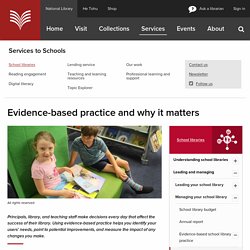
Evidence for practice — existing research Evidence for practice involves examining and using existing research to identify best practices and inform changes in practice. It provides compelling evidence that school libraries and library staff have a positive impact on student achievement. Planning successful user-centred change. When you need to make changes in your school library, a systematic approach will help make those changes as successful as possible. Be systematic Using a systematic approach can help you: understand what's going on for your library users consider the consequences of proposed changes make decisions based on sound evidence know what actions are needed to achieve your goals.
Document Analysis Worksheets. Document analysis is the first step in working with primary sources. Teach your students to think through primary source documents for contextual understanding and to extract information to make informed judgments. Use these worksheets — for photos, written documents, artifacts, posters, maps, cartoons, videos, and sound recordings — to teach your students the process of document analysis. Follow this progression: The first few times you ask students to work with primary sources, and whenever you have not worked with primary sources recently, model careful document analysis using the worksheets. Point out that the steps are the same each time, for every type of primary source: Meet the document.
Don’t stop with document analysis though. Inspiring inquiry through picture books. — KATH MURDOCH. "The bridge will only take you halfway there, to those mysterious lands you long to see.

Through gypsy camps and swirling Arab fair, and moonlit woods where unicorns run free. So come and walk awhile with me and share the twisting trails and wondrous worlds I've known. But this bridge will only take you halfway there. Services to Schools. Fertile questions are questions that are deep, complex, and perfect for inquiry.
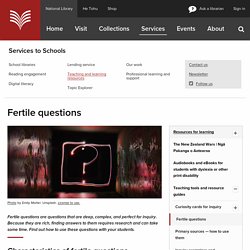
Because they are rich, finding answers to them requires research and can take some time. Find out how to use these questions with your students. Characteristics of fertile questions Fertile questions have some or most of the following characteristics: Open — they have no one, definitive answer but rather several different and possibly competing answers. The fertile questions model was developed by Yoram Harpaz and Adam Lefstein. Teaching and learning in a community of thinking (pdf, 325KB) has more about this model. Examples of fertile questions. Primary Sources in the Library: From Object to Inquiry: EBSCOhost. Primary sources — how to use them. Primary sources are a powerful teaching and learning tool.
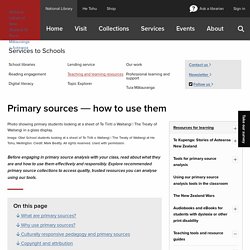
Find out what they are, how to find quality, trusted primary sources, and how to use them effectively and responsibly Primary sources are original, first-hand, often unedited records of an event. They are created as people experience events and record what they saw, heard, and felt. Primary sources are characterised by their content, regardless of their format. Many Answers. Acceptable use means acting like a good citizen online.
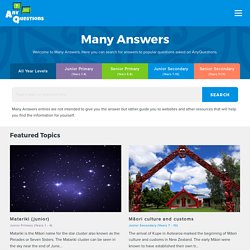
How you behave online should be the same as how you behave offline (in the real world). AnyQuestions is a free service, staffed by real people from libraries right around New Zealand. Please be respectful and polite to our librarians. We like helping people who show good manners :) We may end a chat session if we think you are being inappropriate or misbehaving, this includes: Using racist/sexist, offensive or obscene language.Please don’t use mean or cruel words when talking to or about someone else; whether they are a male or female, or of another race or skin colour. Services to Schools. When you use any of the digital resources included in DigitalNZ, be aware of their copyright requirements and usage restrictions.
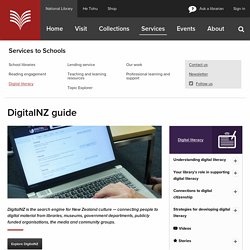
These are made clear on the DigitalNZ site. DigitalNZ copyright If you use resources from DigitalNZ, it's important that you acknowledge or attribute them in your work. Services to Schools. Using EPIC, schools have access to thousands of electronic resources covering all curriculum learning areas from primary to secondary level.

It includes magazines, newspapers, encyclopedia, images, and much more. Explore EPIC What's EPIC? EPIC (Electronic Purchasing In Collaboration) is a consortium of New Zealand library and information organisations that have purchased collective access to a wide range of quality e-resources. The Ministry of Education is a member of EPIC and has made EPIC e-resources freely available to all New Zealand schools. Services to Schools. Topic Explorer guide. He Tohu. Inquiry exemplars and templates. Approaches to inquiry learning-2020.pdf. Inquiry learning / Effective pedagogy / Media gallery / Curriculum resources / Kia ora - NZ Curriculum Online.
Vic Hygate, Windsor School, Christchurch.
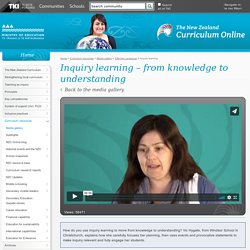
InquiringMindsWantToKnow Stripling. Understanding inquiry learning. A student-centred approach is a key feature of inquiry-based learning.
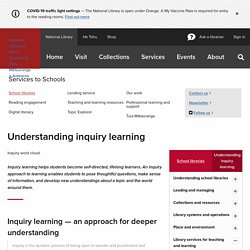
Using an inquiry approach, students learn how to learn. They can often transfer or apply the essential inquiry learning skills, dispositions, and attitudes to new situations. Metacognitive processes can be an important part of inquiry learning. This might include strategies for developing students' thinking skills and understanding how they learn. The New School Library. Without question, the Internet has changed the way we think and learn, and will continue to do so as our technology evolves.
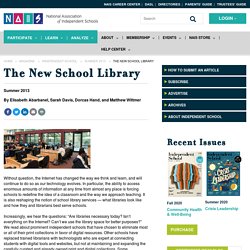
In particular, the ability to access enormous amounts of information at any time from almost any place is forcing schools to redefine the idea of a classroom and the way we approach teaching. InquiringMindsWantToKnow Stripling. Advanced Search. Advanced Search. Choosing good keywords.
Supporting inquiry learning in kura kaupapa Māori. Āria matua — key concept An āria matua / key concept connects the ākonga to why the topic is important to learn about. For example: 'Mena kāhore tātou e ako ana ki te hangarua ka kīkī haere ngā wāhi rāpihi.' Mahi whakarite — pre-teaching In order for ākonga to engage and ask questions about a kaupapa, they first need some basic knowledge about it. A kaiako (teacher) can provide ākonga with some facts/concepts/understandings so that they can engage more effectively in brainstorming.